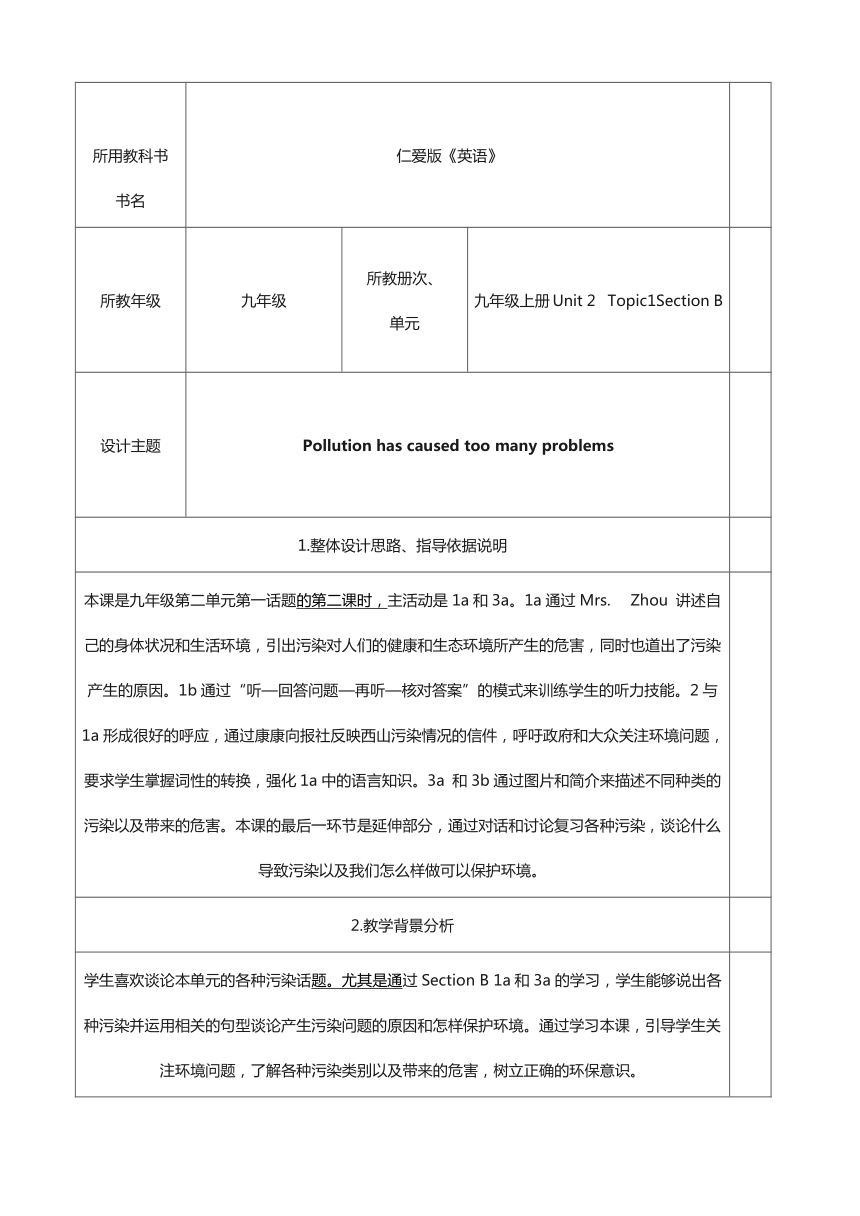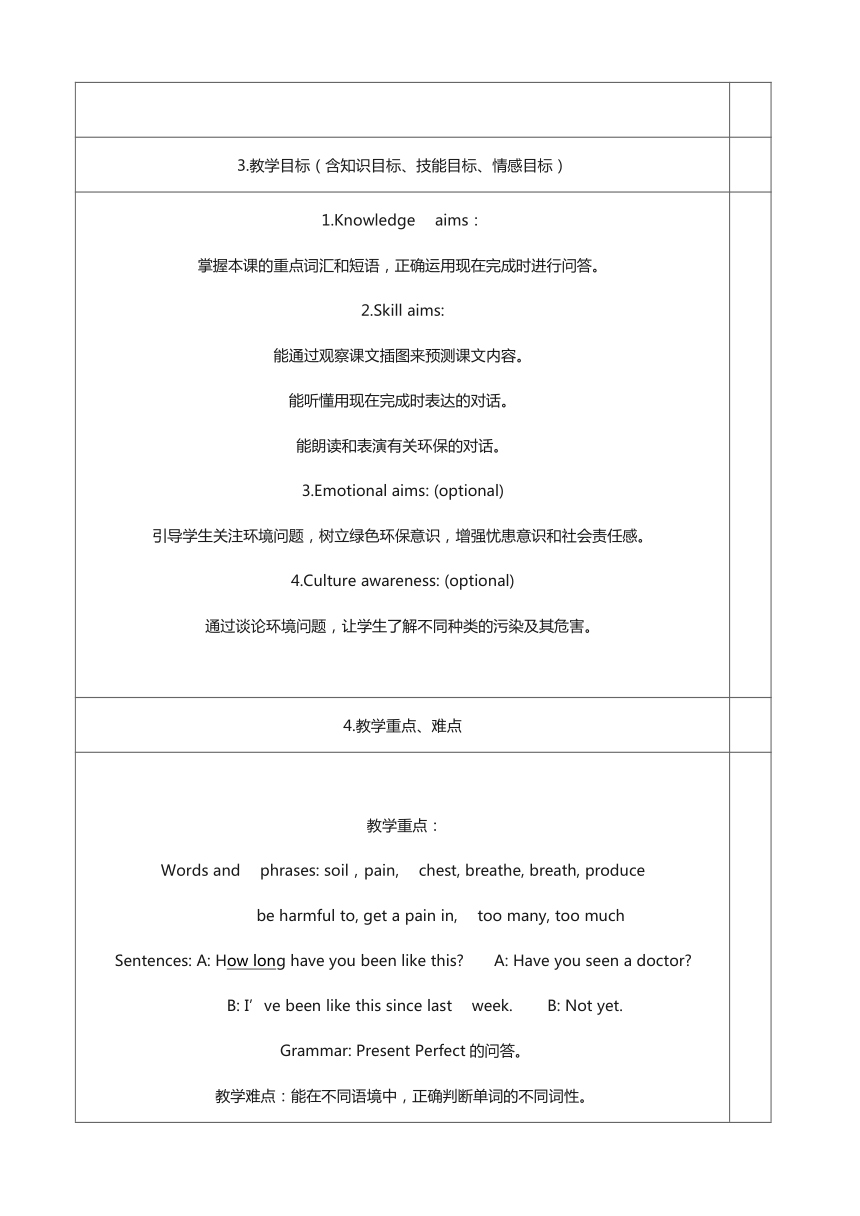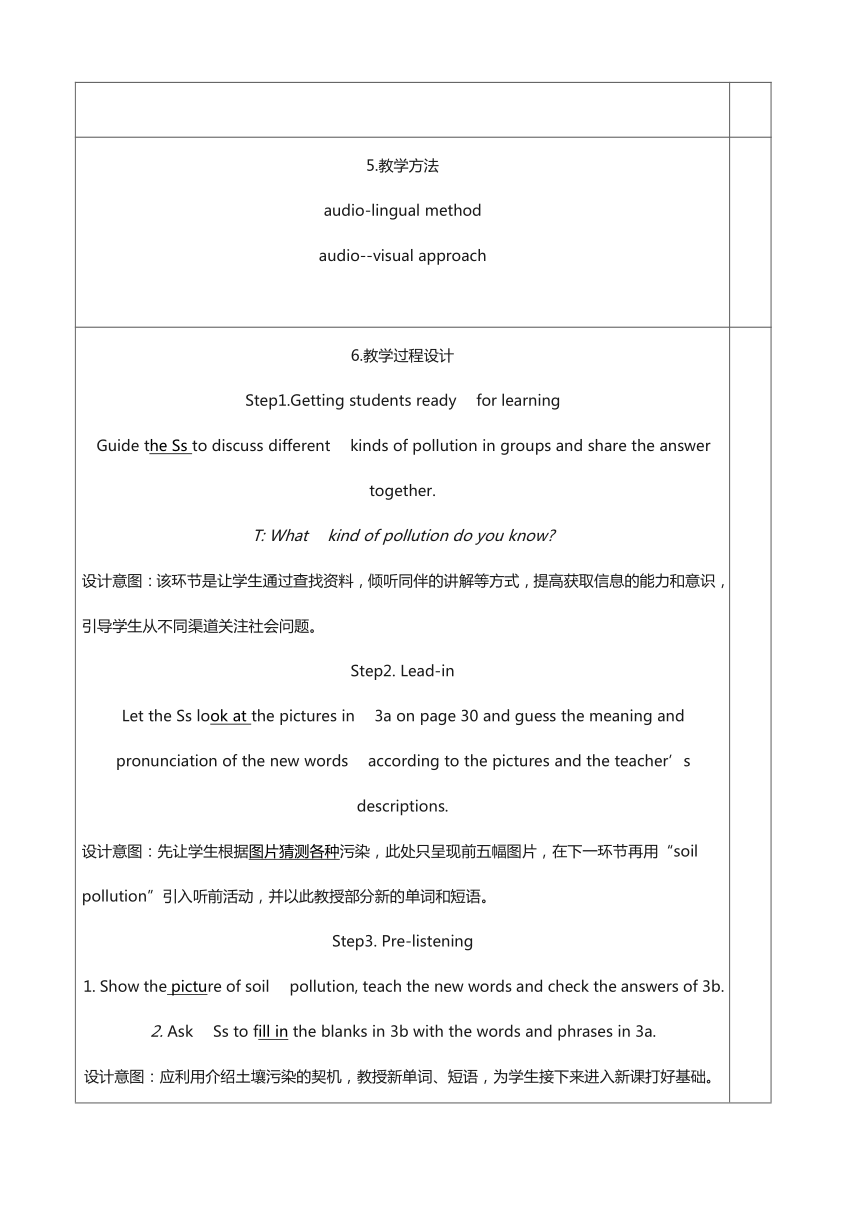2016年10月海南省初中英语教师课堂教学评比暨观摩活动:仁爱版九年级上册 Unit 2 Topic1 Section B教学设计与教学反思
文档属性
| 名称 | 2016年10月海南省初中英语教师课堂教学评比暨观摩活动:仁爱版九年级上册 Unit 2 Topic1 Section B教学设计与教学反思 |

|
|
| 格式 | zip | ||
| 文件大小 | 18.7KB | ||
| 资源类型 | 教案 | ||
| 版本资源 | 科学普及版 | ||
| 科目 | 英语 | ||
| 更新时间 | 2016-10-16 17:21:36 | ||
图片预览



文档简介
所用教科书书名
仁爱版《英语》
所教年级
九年级
所教册次、单元
九年级上册Unit
2
Topic1Section
B
设计主题
Pollution
has
caused
too
many
problems
1.整体设计思路、指导依据说明
本课是九年级第二单元第一话题的第二课时,
( http: / / www.21cnjy.com )主活动是1a和3a。1a通过Mrs.
Zhou
讲述自己的身体状况和生活环境,引出污染对人们的健康和生态环境所产生的危害,同时也道出了污染产生的原因。1b通过“听—回答问题—再听—核对答案”的模式来训练学生的听力技能。2与1a形成很好的呼应,通过康康向报社反映西山污染情况的信件,呼吁政府和大众关注环境问题,要求学生掌握词性的转换,强化1a中的语言知识。3a
和3b通过图片和简介来描述不同种类的污染以及带来的危害。本课的最后一环节是延伸部分,通过对话和讨论复习各种污染,谈论什么导致污染以及我们怎么样做可以保护环境。
2.教学背景分析
学生喜欢谈论本单元的各种污染话题。尤其是通
( http: / / www.21cnjy.com )过Section
B
1a和3a的学习,学生能够说出各种污染并运用相关的句型谈论产生污染问题的原因和怎样保护环境。通过学习本课,引导学生关注环境问题,了解各种污染类别以及带来的危害,树立正确的环保意识。
3.教学目标(含知识目标、技能目标、情感目标)
1.Knowledge
aims:掌握本课的重点词汇和短语,正确运用现在完成时进行问答。2.Skill
aims:能通过观察课文插图来预测课文内容。能听懂用现在完成时表达的对话。能朗读和表演有关环保的对话。3.Emotional
aims:
(optional)引导学生关注环境问题,树立绿色环保意识,增强忧患意识和社会责任感。4.Culture
awareness:
(optional)通过谈论环境问题,让学生了解不同种类的污染及其危害。
4.教学重点、难点
教学重点:Words
and
phrases:
soil,pain,
chest,
breathe,
breath,
produce
be
harmful
to,
get
a
pain
in,
too
many,
too
muchSentences:
A:
How
lon
( http: / / www.21cnjy.com )g
have
you
been
like
this
A:
Have
you
seen
a
doctor
B:
I’ve
been
like
this
since
last
week.
B:
Not
yet. Grammar:
Present
Perfect的问答。 教学难点:能在不同语境中,正确判断单词的不同词性。
5.教学方法audio-lingual methodaudio--visual approach
6.教学过程设计Step1.Getting
students
ready
for
learningGuide
the
Ss
( http: / / www.21cnjy.com )to
discuss
different
kinds
of
pollution
in
groups
and
share
the
answer
together.T:
What
kind
of
pollution
do
you
know 设计意图:该环节是让学生通过查找资料,倾听同伴的讲解等方式,提高获取信息的能力和意识,引导学生从不同渠道关注社会问题。Step2.
Lead-inLet
the
Ss
look
at
( http: / / www.21cnjy.com )the
pictures
in
3a
on
page
30
and
guess
the
meaning
and
pronunciation
of
the
new
words
according
to
the
pictures
and
the
teacher’s
descriptions.设计意图:先让学生根据图片猜测各种
( http: / / www.21cnjy.com )污染,此处只呈现前五幅图片,在下一环节再用“soil
pollution”引入听前活动,并以此教授部分新的单词和短语。Step3.
Pre-listening1.
Show
the
pictu
( http: / / www.21cnjy.com )re
of
soil
pollution,
teach
the
new
words
and
check
the
answers
of
3b.2.
Ask
Ss
to
fill
in
( http: / / www.21cnjy.com )
the
blanks
in
3b
with
the
words
and
phrases
in
3a.设计意图:应利用介绍土壤污染的契机,教授新单词、短语,为学生接下来进入新课打好基础。Step4.While-listening1.
Show
a
pic
( http: / / www.21cnjy.com )ture
of
the
polluted
West
Hill,
let
the
Ss
listen
to
1a
once
and
tick
the
questions
they
hear
in
part
A
of
1b.
Then
check
the
answers
together.2.
Get
the
S
( http: / / www.21cnjy.com )s
to
listen
again
and
match
the
questions
with
the
right
answers
in
part
B
of
1b.
Then
check
the
answers
together.设计意图:通过“听—回答问题—再听—核对答案”的模式来训练学生的听力技能。Step5.Post-listening1.Get
the
Ss
to
read
1a
and
answer
the
questions
in
1c.2.
Let
the
Ss
read
( http: / / www.21cnjy.com )1a
after
the
video.
After
that,
read
1a
again
in
different
roles.3.
Let
the
Ss
read
( http: / / www.21cnjy.com )1a
carefully
and
underline
the
difficult
points
including
words,
phrases
and
sentences.
Then
lead
the
Ss
to
ask
their
classmates
and
teacher
for
help.
Write
down
the
points
they
can’t
understand
on
the
book.4.
Lead
the
Ss
to
( http: / / www.21cnjy.com )
scan
the
material
and
choose
the
correct
words
to
complete
the
letter
in
2.设计意图:通过完成1c的读后任务,进一步
( http: / / www.21cnjy.com )理解对话内容。在完成该任务时,如果答案不能直接从课文中找出,要引导学生学会用自己的语言总结和归纳答案,允许有不同的表达方式。教师需要引导学生,一步一步朝着正确答案去思考,可以运用课文中的文本语言,也可以拓展例句提供新的语境,还可以根据已学知识理解新知识。Step6.
Practice1.
Show
a
picture
( http: / / www.21cnjy.com )to
the
students
and
ask
them
what
is
wrong
with
the
two
birds.2.
Work
in
pairs
and
make
up
a
conversation
based
on
1a.A:
What’s
wrong
with
you B:
I.....A:
How
long
have
you..... B:
I’ve
been……A:
What
caused
the
pollution B:
The
factory
produces……3.
Discuss
in
groups.Pollution
has
cau
( http: / / www.21cnjy.com )sed
too
many
problems.
It
makes
the
environment
worse
than
before.
What
should
we
do 设计意图:通过漫画中两只小鸟的
( http: / / www.21cnjy.com )对话,让学生仿照1a编一个对话,对话完成后,通过对污染的学习,引导学生要树立环保意识,讨论如何保护环境,让学生运用本节课所学到的词汇、句型来组织自己的语言。这一环节主要是培养学生的语言组织能力和语言表达能力。Step7.Summarizing
and
assigning
homework1.
Let
the
Ss
go
ov
( http: / / www.21cnjy.com )er
what
they
have
learned
this
period.
Sum
up
the
key
points.T:It’s
our
duty
to
protect
the
environment.2.
Homework
Try
your
best
to
( http: / / www.21cnjy.com )recite
the
new
words
and
read
the
dialogue
fluently.
Preview
Section
C.设计意图:小结本节课的单词、词汇和句型。教师最后引导学生总结保护环境,人人有责,增强学生的绿色环保意识和社会责任感。
7.板书设计Blackboard
design
Pollution
has
caused
too
many
problems. Section
B Words
: soil pain chest breathe breath produce Phrases: be
harmful
to, get
a
pain
in…, too
much too
many Pollution: air
pollution water
pollution noise
pollution soil
pollution light
pollution litter
教学反思
这节课是九年级上册Unit2
( http: / / www.21cnjy.com )
Topic1
Section
B
Pollution
has
caused
too
many
problems一节听说课。由于这节课讲述的和污染有关,所以在导入部分运用各种污染的图片引导学生熟悉各种污染,并引入新的单词和句型。整堂课以听说为主,通过两个听力训练,加深学生对教材内容的理解。阅读后回答问题是对课文内容的一个提炼。对教材分析完后我设置了一个新的与本节课污染话题有关的图,为了让学生有更好的“输出”,以设问的方式带着学生描述图片,有了这个“热身”后,让学生根据图片,仿造1a来编一个对话,在这里有给出提示句型。最后讨论是对本节课一个情感上的升华,也是对学生品质的一种培养。谈论如何保护环境。引导学生关注环境问题,树立绿色环保意识,增强忧患意识和社会责任感。保护环境人人有责。
整节课的亮点在于,教学环节紧凑,环环相
( http: / / www.21cnjy.com )扣,层层推进。设计的活动,学生都能较好的完成,从老师的“输入”到学生的“输出”都有很好的体现。不足之处在于,对话演练部分应该再多一些组来练习。讨论环节中,由于时间仓促,来不及让学生发表太多的自己观点,只能根据我所提供的图片来回答保护环境的一些措施,给学生自由发挥的空间有点少。通过这样的活动,我也确实学到了许多新的教学方法,对英语教学也有了更深层次的理解。对于本节课的不足,在今后的听说课中我会更加注意。
仁爱版《英语》
所教年级
九年级
所教册次、单元
九年级上册Unit
2
Topic1Section
B
设计主题
Pollution
has
caused
too
many
problems
1.整体设计思路、指导依据说明
本课是九年级第二单元第一话题的第二课时,
( http: / / www.21cnjy.com )主活动是1a和3a。1a通过Mrs.
Zhou
讲述自己的身体状况和生活环境,引出污染对人们的健康和生态环境所产生的危害,同时也道出了污染产生的原因。1b通过“听—回答问题—再听—核对答案”的模式来训练学生的听力技能。2与1a形成很好的呼应,通过康康向报社反映西山污染情况的信件,呼吁政府和大众关注环境问题,要求学生掌握词性的转换,强化1a中的语言知识。3a
和3b通过图片和简介来描述不同种类的污染以及带来的危害。本课的最后一环节是延伸部分,通过对话和讨论复习各种污染,谈论什么导致污染以及我们怎么样做可以保护环境。
2.教学背景分析
学生喜欢谈论本单元的各种污染话题。尤其是通
( http: / / www.21cnjy.com )过Section
B
1a和3a的学习,学生能够说出各种污染并运用相关的句型谈论产生污染问题的原因和怎样保护环境。通过学习本课,引导学生关注环境问题,了解各种污染类别以及带来的危害,树立正确的环保意识。
3.教学目标(含知识目标、技能目标、情感目标)
1.Knowledge
aims:掌握本课的重点词汇和短语,正确运用现在完成时进行问答。2.Skill
aims:能通过观察课文插图来预测课文内容。能听懂用现在完成时表达的对话。能朗读和表演有关环保的对话。3.Emotional
aims:
(optional)引导学生关注环境问题,树立绿色环保意识,增强忧患意识和社会责任感。4.Culture
awareness:
(optional)通过谈论环境问题,让学生了解不同种类的污染及其危害。
4.教学重点、难点
教学重点:Words
and
phrases:
soil,pain,
chest,
breathe,
breath,
produce
be
harmful
to,
get
a
pain
in,
too
many,
too
muchSentences:
A:
How
lon
( http: / / www.21cnjy.com )g
have
you
been
like
this
A:
Have
you
seen
a
doctor
B:
I’ve
been
like
this
since
last
week.
B:
Not
yet. Grammar:
Present
Perfect的问答。 教学难点:能在不同语境中,正确判断单词的不同词性。
5.教学方法audio-lingual methodaudio--visual approach
6.教学过程设计Step1.Getting
students
ready
for
learningGuide
the
Ss
( http: / / www.21cnjy.com )to
discuss
different
kinds
of
pollution
in
groups
and
share
the
answer
together.T:
What
kind
of
pollution
do
you
know 设计意图:该环节是让学生通过查找资料,倾听同伴的讲解等方式,提高获取信息的能力和意识,引导学生从不同渠道关注社会问题。Step2.
Lead-inLet
the
Ss
look
at
( http: / / www.21cnjy.com )the
pictures
in
3a
on
page
30
and
guess
the
meaning
and
pronunciation
of
the
new
words
according
to
the
pictures
and
the
teacher’s
descriptions.设计意图:先让学生根据图片猜测各种
( http: / / www.21cnjy.com )污染,此处只呈现前五幅图片,在下一环节再用“soil
pollution”引入听前活动,并以此教授部分新的单词和短语。Step3.
Pre-listening1.
Show
the
pictu
( http: / / www.21cnjy.com )re
of
soil
pollution,
teach
the
new
words
and
check
the
answers
of
3b.2.
Ask
Ss
to
fill
in
( http: / / www.21cnjy.com )
the
blanks
in
3b
with
the
words
and
phrases
in
3a.设计意图:应利用介绍土壤污染的契机,教授新单词、短语,为学生接下来进入新课打好基础。Step4.While-listening1.
Show
a
pic
( http: / / www.21cnjy.com )ture
of
the
polluted
West
Hill,
let
the
Ss
listen
to
1a
once
and
tick
the
questions
they
hear
in
part
A
of
1b.
Then
check
the
answers
together.2.
Get
the
S
( http: / / www.21cnjy.com )s
to
listen
again
and
match
the
questions
with
the
right
answers
in
part
B
of
1b.
Then
check
the
answers
together.设计意图:通过“听—回答问题—再听—核对答案”的模式来训练学生的听力技能。Step5.Post-listening1.Get
the
Ss
to
read
1a
and
answer
the
questions
in
1c.2.
Let
the
Ss
read
( http: / / www.21cnjy.com )1a
after
the
video.
After
that,
read
1a
again
in
different
roles.3.
Let
the
Ss
read
( http: / / www.21cnjy.com )1a
carefully
and
underline
the
difficult
points
including
words,
phrases
and
sentences.
Then
lead
the
Ss
to
ask
their
classmates
and
teacher
for
help.
Write
down
the
points
they
can’t
understand
on
the
book.4.
Lead
the
Ss
to
( http: / / www.21cnjy.com )
scan
the
material
and
choose
the
correct
words
to
complete
the
letter
in
2.设计意图:通过完成1c的读后任务,进一步
( http: / / www.21cnjy.com )理解对话内容。在完成该任务时,如果答案不能直接从课文中找出,要引导学生学会用自己的语言总结和归纳答案,允许有不同的表达方式。教师需要引导学生,一步一步朝着正确答案去思考,可以运用课文中的文本语言,也可以拓展例句提供新的语境,还可以根据已学知识理解新知识。Step6.
Practice1.
Show
a
picture
( http: / / www.21cnjy.com )to
the
students
and
ask
them
what
is
wrong
with
the
two
birds.2.
Work
in
pairs
and
make
up
a
conversation
based
on
1a.A:
What’s
wrong
with
you B:
I.....A:
How
long
have
you..... B:
I’ve
been……A:
What
caused
the
pollution B:
The
factory
produces……3.
Discuss
in
groups.Pollution
has
cau
( http: / / www.21cnjy.com )sed
too
many
problems.
It
makes
the
environment
worse
than
before.
What
should
we
do 设计意图:通过漫画中两只小鸟的
( http: / / www.21cnjy.com )对话,让学生仿照1a编一个对话,对话完成后,通过对污染的学习,引导学生要树立环保意识,讨论如何保护环境,让学生运用本节课所学到的词汇、句型来组织自己的语言。这一环节主要是培养学生的语言组织能力和语言表达能力。Step7.Summarizing
and
assigning
homework1.
Let
the
Ss
go
ov
( http: / / www.21cnjy.com )er
what
they
have
learned
this
period.
Sum
up
the
key
points.T:It’s
our
duty
to
protect
the
environment.2.
Homework
Try
your
best
to
( http: / / www.21cnjy.com )recite
the
new
words
and
read
the
dialogue
fluently.
Preview
Section
C.设计意图:小结本节课的单词、词汇和句型。教师最后引导学生总结保护环境,人人有责,增强学生的绿色环保意识和社会责任感。
7.板书设计Blackboard
design
Pollution
has
caused
too
many
problems. Section
B Words
: soil pain chest breathe breath produce Phrases: be
harmful
to, get
a
pain
in…, too
much too
many Pollution: air
pollution water
pollution noise
pollution soil
pollution light
pollution litter
教学反思
这节课是九年级上册Unit2
( http: / / www.21cnjy.com )
Topic1
Section
B
Pollution
has
caused
too
many
problems一节听说课。由于这节课讲述的和污染有关,所以在导入部分运用各种污染的图片引导学生熟悉各种污染,并引入新的单词和句型。整堂课以听说为主,通过两个听力训练,加深学生对教材内容的理解。阅读后回答问题是对课文内容的一个提炼。对教材分析完后我设置了一个新的与本节课污染话题有关的图,为了让学生有更好的“输出”,以设问的方式带着学生描述图片,有了这个“热身”后,让学生根据图片,仿造1a来编一个对话,在这里有给出提示句型。最后讨论是对本节课一个情感上的升华,也是对学生品质的一种培养。谈论如何保护环境。引导学生关注环境问题,树立绿色环保意识,增强忧患意识和社会责任感。保护环境人人有责。
整节课的亮点在于,教学环节紧凑,环环相
( http: / / www.21cnjy.com )扣,层层推进。设计的活动,学生都能较好的完成,从老师的“输入”到学生的“输出”都有很好的体现。不足之处在于,对话演练部分应该再多一些组来练习。讨论环节中,由于时间仓促,来不及让学生发表太多的自己观点,只能根据我所提供的图片来回答保护环境的一些措施,给学生自由发挥的空间有点少。通过这样的活动,我也确实学到了许多新的教学方法,对英语教学也有了更深层次的理解。对于本节课的不足,在今后的听说课中我会更加注意。
同课章节目录
- Unit 1 The Changing World
- Topic 1 Our country has developed rapidly.
- Topic 2 The population in developing countries is
- Topic 3 The world has changed for the better.
- Unit 2 Saving the earth.
- Topic 1 Pollution has causes too many problems.
- Topic 2 All these problems are very serious.
- Topic 3 What can we do to protect the environment
- Unit 3 English around the World
- Topic 1 English is widely spoken around the world.
- Topic 2 Some things usually have different meaning
- Topic 3 Could you give us some advice on how to l
- Unit 4 Amazing Science
- Topic 1 When was it invented?
- Topic 2 I'm excited about the things that will be
- Topic 3 China is the third nation that sent a pers
